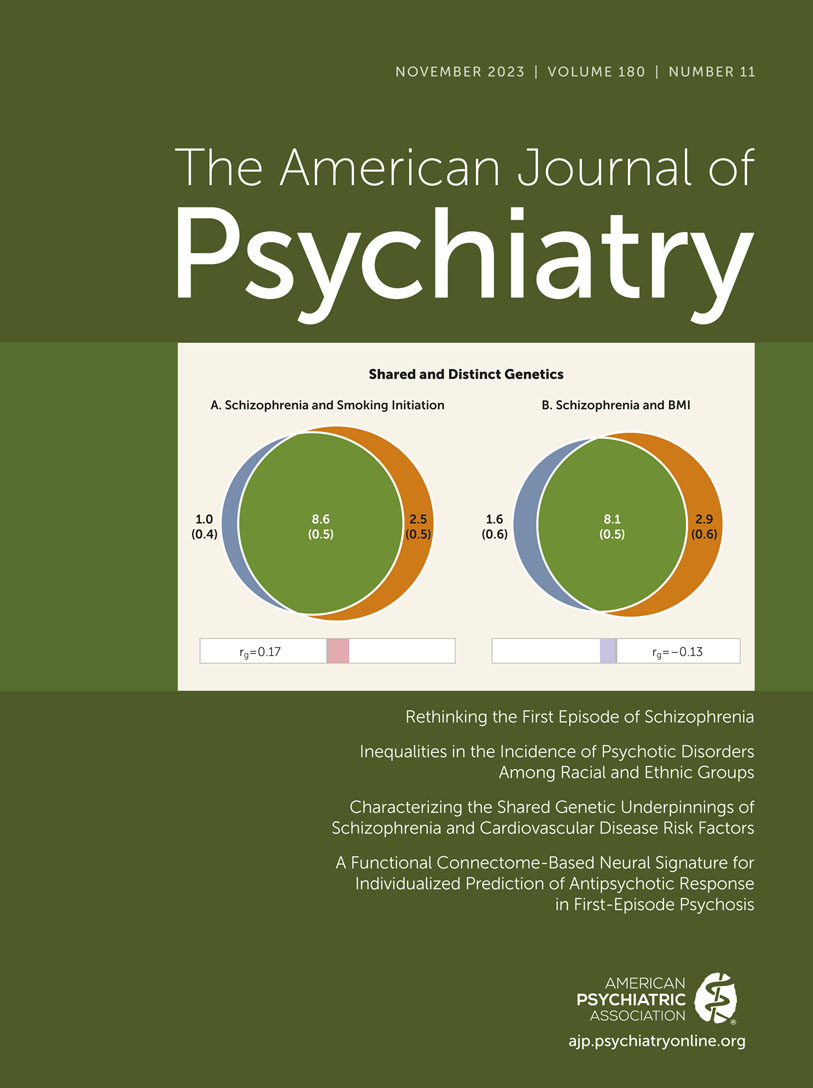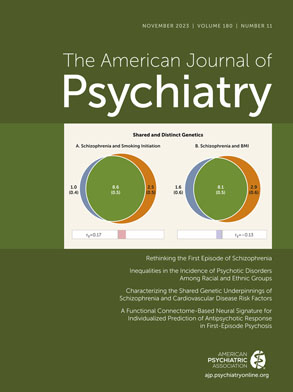In this issue, Chung et al. (
1) report on ethnoracial differences in the incidence of treated psychotic disorders among nearly 6 million persons enrolled in Kaiser Permanente Northern California (KPNC) who were followed for part or all of 2009–2019. Ethnoracial groups were derived from electronic health records. KPNC members could choose to self-identify as African American or Black (henceforth “Black”), Latino or Hispanic (henceforth “Hispanic”), American Indian or Alaskan Native (henceforth “Native American”), non-Hispanic White (henceforth “White”), Asian American, Hawaiian or other Pacific Islander, or “other.” The authors found an approximately twofold higher treated incidence of nonaffective psychoses among Black than White members of KPNC. This difference is essentially the same result reported by the only previous incidence study to make this comparison (
2), which was also done within a population insured by KPNC. The earlier study was based on research diagnostic interviews in a cohort followed since birth (N=12,094), whereas the Chung et al. study used electronic health records and was substantially larger (N=5,994,758). In addition, Chung et al. extended the scope by reporting on affective psychoses and including other ethnoracial groups. In comparison with White members, they found a higher incidence of nonaffective psychoses among Black and Native American members but not among members of the remaining groups. The authors also found a higher incidence of affective psychoses, although the magnitude of the difference was smaller, among both Black and Native American individuals compared with White individuals; the same relationship was not observed with the remaining groups, except for a slightly higher incidence among Hispanic individuals. A notable finding among the remaining groups was that Asian American individuals had lower treated incidence of both nonaffective and affective psychoses.
Although all the ethnoracial comparisons are of interest, each comparison is difficult to interpret in its own way. We focus on how to interpret the higher incidence of nonaffective psychoses among Black compared with White members. This disparity in incidence is consistent with reports of disparity in prevalence in Black versus White persons, particularly in a recent national survey using diagnostic interviews (
3). Prevalence cannot substitute for incidence in studies of causation, however, especially when comparing Black and White persons. Disparities in treatment and living conditions after illness onset are likely to affect duration of illness and thereby prevalence but are not causes of illness onset. Despite the salience of Black-White disparities in schizophrenia, the scarcity of high-quality population-based incidence data in the United States and the absence of measures of diagnostic bias (overdiagnosis of Black people) in incidence studies have limited our progress in understanding the underlying causes.
Numerous studies from Europe indicate high incidence of psychotic disorders among various migrant and ethnic minority populations. This literature has evolved almost entirely separately from research in the United States, mainly because of differences in the sociohistorical contexts. European countries colonized most of the globe and considered “nonwhite” colonized peoples to be lower on a racialized hierarchy of human beings (
4), but these countries depended largely on enslaved labor and seizure of land and treasure in colonized areas outside Europe for the accumulation of wealth. While these differences limit comparability, there may be common denominators underlying these disparities. In the United Kingdom, the Aetiology and Ethnicity in Schizophrenia and Other Psychoses study indicated an up to eightfold higher incidence risk of psychotic disorder among Black Caribbeans from former British colonies and an up to sixfold higher risk among Black African immigrant groups (
5). Similarly, incidence studies from elsewhere in Europe (
6–
9) indicated markedly increased incidence among immigrants from Africa and the Caribbean and across two generations of their descendants. Overall, empirical studies suggest that diagnostic bias makes a limited contribution to these findings (
5,
6). Thus, we have robust evidence that disparities in risk of psychotic disorder across ethnic minority populations in Europe exist and are especially pronounced among people considered Black. Studies suggest that racial discrimination contributes to these disparities in incidence (
6), but researchers have not gauged the impact of racial discrimination differentiated from the broad umbrella of social disadvantage.
Here, we examine evidence for structural racism being the primary cause of the Black-White disparity in the incidence of psychotic disorder in the United States. We then propose ways in which future research might verify and elucidate causal pathways from structural racism to the disparity. Structural racism has been defined as the “totality of ways in which societies foster racial discrimination, through mutually reinforcing systems in housing, education, employment . . . these patterns and practices in turn reinforce discriminatory beliefs, values, and distribution of resources” (
10). Taken together, these factors affect the risk of adverse health outcomes. Thus, structural racism is not a characteristic of individuals, but a historical and ongoing societal relationship of power that disadvantages Black people and other groups, such as Native Americans. Structural racism is deeply rooted in the United States; the nation was founded as a White settler colony and its growth up to the 20th century was based largely on the dispossession and virtual extermination of indigenous peoples and on the transportation and enslavement of Black people. With respect to people designated as Black, explicit subjugation and devaluation continued after emancipation and Reconstruction in other forms until well after World War II, based on Jim Crow laws and the sharecropping system in the South and on discriminatory federal, state, and local laws and practices across the nation as a whole. Notwithstanding the long history of resistance and legal victories such as the Civil Rights Act of 1965, structural racism remains embedded in our society, both in the legacy of disadvantage and in ongoing, less explicitly formulated practices. In California, where the Chung et al. study was done, discrimination against Black people (and others designated as non-White) was deeply rooted among White settlers even before California was incorporated into the United States (
11). We now have good evidence that structural racism is the root cause of manifold Black-White health disparities in the United States, exemplified by shorter life expectancy and alarmingly high maternal mortality among Black people (
10).
In theory, it seems eminently plausible that the adverse health effects of structural racism could include schizophrenia (
12,
13). Indeed, in the United States, exposure to various environmental conditions that have been associated with an increased risk of schizophrenia is shaped by inequitable systems driven by racial discrimination. One important example constitutes the place where someone lives. As a result of practices of racial segregation, Black people are overrepresented in neighborhoods where exposures associated with schizophrenia risk, such as residential instability, unemployment, environmental pollution, and lack of green space, are more likely to occur. Another example is the impact of structural racism on maternal morbidity and mortality, in particular the high risk of obstetric complications among Black mothers, given that disruptions in early neurodevelopment contribute to the risk of schizophrenia.
Nonetheless, there is a dearth of direct evidence on the contribution of structural racism to the risk of schizophrenia in the United States. Moreover, for schizophrenia, especially in the United States, making sense of disparities in incidence is a fraught question. One has to be careful in associating a highly stigmatized illness with a racialized group. The hazards include mistakenly interpreting the disparity as being due to genetic differences and further devaluing Black people by association with the illness. In addition, there are many stages in the process of identifying an incident case that could introduce biases that may disproportionally affect minoritized groups. Diagnosing a person based on a set of symptoms remains partially subjective and is susceptible to artifactual diagnoses. The United States has a long-standing history of diagnostic bias, with Black Americans more likely to be diagnosed with schizophrenia than White people with similar symptoms (
14). There is evidence that this bias still occurs to some degree—for example, when behaviors of Black Americans are misinterpreted as disorganized and psychotic (
15)—and such a bias could contribute to the disparity. In our view as well as others’ (
12,
13), however, the literature does not offer convincing evidence that diagnostic bias can explain most of the disparity that is apparent in analyses based on electronic health records and research diagnostic interviews. Nonetheless, we must keep in mind how challenging it is to produce reliable estimates of the incidence of psychosis irrespective of the study design. For example, limitations of the Chung et al. study include unknown diagnostic bias reflected in electronic health records, selection bias in that KPNC members encompass a broad swath of the population but underrepresent individuals with very low socioeconomic status, and selection bias due to missing those who do not seek treatment. The diagnostic bias could inflate increased estimates of incidence among Black individuals, whereas the selection biases could have the opposite effect. We should also note that these artifacts are themselves manifestations of structural racism.
Keeping this in mind, we propose that structural racism could be a large part of the explanation for the observed disparity and that it should be called out and rigorously tested. We suggest three key steps toward advancing our understanding. First, we need to better estimate the true magnitude of the Black-White and other ethnoracial disparities. For example, the use of culturally sensitive instruments, such as the Cultural Formulation Interview of DSM-V-TR, could substantially reduce the contribution of diagnostic bias (
16). This instrument could be applied in future studies of treated incidence done along the lines of the two KPNC studies. Second, we need to differentiate structural racism from other forms of social disadvantage and carefully examine the causal pathways that include all these factors. For example, as a result of structural racism, there are dramatic wealth, income, and educational gaps between Black and White Americans, as well as excessive maternal morbidity and mortality during pregnancy. However, we do not know whether these differences are important mediators on the causal pathway to the Black-White disparity or the degree to which they might have separate and joint effects on disparities in incidence. Researchers should use more refined measures of social disadvantage and multiple descriptors for each study participant to improve our understanding of the role of multiple intersecting characteristics on schizophrenia risk (
17). Ethnoracial designations (e.g., race, ethnicity, and nationality) should be applied with careful thought (
17). This can be done in a manner that also allows for comparisons with studies that have access only to census or chart records. Third, we need to examine the direct contribution of the subjective interpersonal and societal experiences of racial discrimination.
Importantly, a certain amount of humility is necessary in this controversial field. The salient example of the unexpected but consistent finding of lower risk of depression among Black compared with White Americans demonstrates the complexity of disparity research. Although a lower risk is counterintuitive given the higher level of stressful life events experienced by Black Americans, the finding does not appear to be artifactual and is likely due to pathways not yet established (
18). Along similar lines, we must be open to counterintuitive findings on schizophrenia that do not fit our preconceptions.

